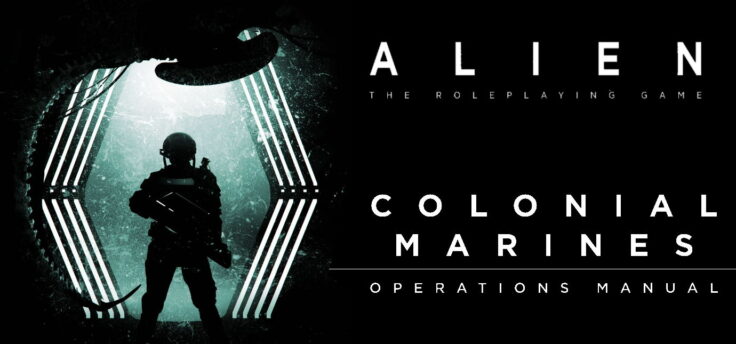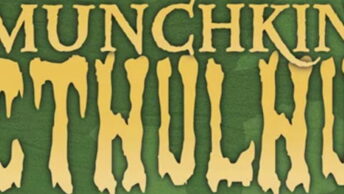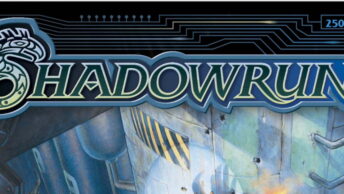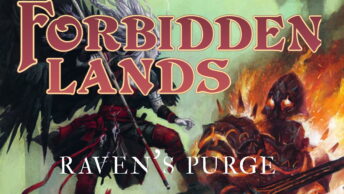Splatbooks don’t get much better than this
Free League
Genre: Tabletop RPG
Developer: Free League Publishing
Publisher: Free League Publishing
Release date: 17 Aug 2021


The Alien RPG (reviewed earlier) was released in 2019 and made quite a splash on the RPG market. Not only did it win the “best game of the year” award at the ENNIEs, but it also seems to have sold really well. And that’s well deserved, as the game did an excellent job at capturing the feel of the Alien setting, while at the same time not feeling like it was shackled to just the event of the movies, or even the xenomorphs. The first standalone adventure released for it, Destroyer of Worlds (also reviewed earlier), was also really good.
The Colonial Marines Operations Manual is the first in a series of books that will focus on different aspects of the Alien setting. This one, as the name would imply, will focus on the colonial marines. It’s part splatbook, giving more options and equipment for colonial marine characters, part campaign blueprint and part actual campaign for anyone who wants to run, and gives a lot more information about the history of the colonial marines and other fighting forces of the Alien universe.
This review will try to avoid any spoilers for the included campaign, though it’s hard to review a book like this without at least hinting at some of the things players are not meant to know about.

A Primer on the Core and Its History
Life in the USCM is not easy, nor has it ever been. If you’re not getting shot at, or attacked by beasts to terrifying to even think about you’ll spend your time in hypersleep. In hypersleep you won’t age, but everyone you know and love will, and you might come back from a campaign not looking a year older than when you left, only to find that your partner is now 30 years older and your kids have careers of their own. But at least you’re not wasting your life farming muck in the back end of nowhere.
The Colonial Marines Operations Manual gives an overview of what it is like to serve in the corps, and also a history of it. The history section is one of the highlights of the books as it helps flesh out the setting. It takes a slightly different approach to most other history sections in RPG books as it gives multiple timelines, each one focusing on a specific aspect, the integration of androids in the fighting forces, development of biological weapons, wars based on religious beliefs, why the USCM has the position it has in both the United Americas and the Three World Empire and so on. It explains a lot without explaining too much, and overall makes the Alien universe feel larger and more alive.
New Toys & Careers
As the Colonial Marines Operations Manual is meant to be used for marine focused campaigns you would end up with a pretty boring team if you just stuck with the vanilla marine career from the core rulebook. You could mix things up by using other careers to represent different specializations, but now there’s a more elegant solution. In the book are ten new specializations for marines that pretty much work like new professions. Each has their own set of talents, skills and attributes, and the only thing that holds them back from feeling like entirely new professions is the fact that the talents they have are not unique, and there’s overlap between them. The new specializations include hospital corpsmen, smartgunners, breachers, CBRN specialists and a bunch more. There are also five new talents in the book that marine characters can get, and none of them feel out of place.

There’s of course a lot of equipment in the book as well, most of which is designed to kill other people. Some of the new guns might feel a bit superfluous, as they work similarly to guns that were already in the core book, but most of them actually do something interesting that make them more than just “an assault rifle but slightly different”. There’s for an example a chem injector pistol that shoots darts, a stun-gun and an arm-mounted gun that fits into a specific suit used by the UPP. But not everything in the book is meant to be lethal, there’s also some other equipment in there, like jungle boots, as well as different kinds of armour and even parafoils.
Not everything in the book is man portable, there are also a bunch of new vehicles, from light buggies to heavy tanks and even a gun emplacement meant to shoot down ships in low orbit. There are also fare few more flying crafts, including the first aerospace fighters the game has seen thus far. On top of that the book includes three new spaceship types, the most interesting of which is probably the Kremlin class destroyer, which is a weird looking UPP ship, that really shows the difference in design philosophy between the UPP and the UA when it comes to spaceships.
Running a Marine Campaign and GM Material
Most of the book is meant for the GM’s eyes only. There are just over 100 pages with player material, and then another 250 pages of GM facing material, that details how to run a campaign focused on colonial marines, interesting places for them to visit, different mission types, secret projects and also a few pre-made adventures for the campaign. The rest of the review, until the closing thoughts, will be about the GM-facing material.

The events in the Colonial Marines Operations Manual takes place after Destroyer of Worlds, and while it’s entirely possible to run the campaign here without having played Destroyer of Worlds, there are enough spoilers for Destroyer of Worlds in this campaign that doing it the other way around is not really possible, without heavily altering either the Colonial Marines Operations Manual campaign or Destroyer of Worlds.
The material in this book assume that the players will be part of the 33rd Marine Assault Unit’s Kilo Company and stationed aboard the USS Tamb’ltam, a Conestoga-class troop transport/light assault starship. That’s the same class of starship as the USS Sulaco, of Aliens fame. If you want to play the campaign as written in the book sticking to having the players be a part of the 33rd Marine Assault Unit is probably for the best, but if you want to ignore the plot in this book and just make a marine campaign of your own then a lot of the material in the book is still useable.
There’s an overview of the unit, the ship the players are supposed to serve on and also what kind of ordnance they have access to that seems to be a pretty representative overview of what you would expect in any USCM units, like how many vehicles is in a tank platoon, or how a rifle company is organized. Details might differ between different units, but there’s enough here for a GM to have an idea of what these things should look like if they make their own.
Then there’s some information about the player’s role in the squad, and how it’s best to handle it when you’re actually playing. The author seem to want the players to have a fare bit of autonomy regarding what they’ll do, which might not make a whole lot of sense considering the context (since when can grunts give orders?), but it makes for a more enjoyable experience at the table . There’s also some good information about how to actually run a military adventure with other military personnel on the side of the players, how to make it manageable and how to make sure that the players are still the ones who get a chance to shine, despite supposedly only being regular soldiers who are part of a far larger unit.
Marines need something to do, and there are 14 “typical” missions that they might be sent out on in the book. Things like recon, bug hunts, search and rescue and so on, and a table that lets you randomize what the players will do next. These are not complete adventures, but rather just descriptions of what the different mission types entails, and it’s still up to the GM to decide exactly what the players should be doing.
The first GM-facing chapter ends with a recipe for cornbread. Might seem like a weird inclusion, but for anyone who really wants to get in character and eat what the marines eat in Aliens, the recipe could be a fun addition, even if it looks exceptionally bland (I’ve not tried making it).
The Conflict Zone
There’s a war brewing between the UPP and the United Americas, a war fought on a wide front. All in all 19 systems are listen in the book that have some kind of importance to the conflict. Some are military in nature, others more civilian, but they’re all potential places for conflicts to arise. Most systems get a page or less of description, but there’s enough there to at least get a feel for what makes that particular system interesting and important.

One system is given special attention, and that’s the Alpha Boötis system, which houses the planet of Arcturus. This planet is special as it houses intelligent life, that’s very human-like. This of course ties in with the Engineers, who seeded several planets in the past, including earth. There are stats and rules for the main intelligent life on that planet, the arcturians, as well as another life form that lives on the same planet, the ape-like Arctura. Think of the two as analogues to the Eloi and Morlocks from The Time Machine by H.G. Wells and you’ll get the idea of how they work.
Both the UA and the UPP are doing some pretty horrible experiments that they hope will help them get the upper hand in the war. Some of them were already introduced in Destroyer of Worlds, like the artificial womb soldiers (Private Hammer was one), and the xenomorph experiments, but there are also a few new ones in the book. You also get to know what the UPP are up to and why they have an interest in the xenomorphs. Also there’s an attempt at explaining how and why the UA and UPP plan to control the xenomorphs, and why they think it’s a worthwhile project. The explanation might not stand up to closer scrutiny, but at least it makes some sense of one of the parts of the Alien universe that always felt like it was handwaved away. It’s no longer just “Weyland-Yutani wants to breed xenomorphs because Weyland-Yutani are evil and have hubris”. W-Y is still very much an evil corporation with hubris, mind you, but they have an end goal that could sound reasonable when explained to their shareholders, and isn’t that all that matters?
The Main Campaign
The final part of the book is dedicated to the actual main story campaign. This is a pretty substantial campaign that can take a while to play through, although exactly how long will depend on the group, as the pace of the campaign can be set by the GM. There are 7 adventures in the book that make up the story portion of the campaign, where the players will be sent out to do different tasks, and each of the adventures will give them more information about what’s actually going on. What is actually going on? Well, that’s a pretty hefty spoiler and probably best left unsaid in this review. It is pretty interesting though and it ties in well with the greater Alien universe.

The campaign is designed in such a way that most of the adventures can be played in any order, and there are ways to work around issues like the players managing to turn former allies into enemies, or even killing important NPCs. Also, the campaign is written with the assumption that the players won’t just go from point A to point B, but will do smaller activities as well. Basically the missions in the campaign are meant to work with the campaign system presented earlier in the book, and not just as a linear series of challenges. This makes the campaign feel a little bit like the main campaign from Mutant: Year Zero in its structure, even if there are some significant differences (it’s not a map crawl campaign, for an example).
It would not be particularly hard to rip the adventures out of the campaign either and use them as standalone adventures, or as parts of another campaign, and there are even some suggestions for how to do that in each of the adventures. As for the adventures themselves, they’re longer than you would expect from something like this, and it would probably take most groups at least 2 three to four hour sessions to complete just one of them (though if your group was somehow able to complete Chariot of the Gods in one session, these are likely to take a bit under a normal length session), and they’re quite varied, both in theme and intensity.
Layout, Art & Quality
The book is split into two parts, a player’s section and a GM’s section, and the parts are clearly marked with text at the top of each page, which makes it easy for a player to know if they’re somewhere where they’re not supposed to be. The first chapter of the GM section also mostly contain things that it would be okay for the players to know. There’s been some thought put into what information goes where to lower the risk of players accidentally seeing something they should not see, something that is appreciated when a book is meant both as a player resource and as a GM resource.
As for the art it’s, just like in the core rulebook and Destroyer of Worlds, outstanding, though it leans a bit more into the action side of Alien than the art in the core rulebook did. Some of the art is recycled from past books though and there are times when you can go quite a few pages without seeing any art, so there’s not enough of it.
Few publishers make RPG books that are as high quality as Free League, and the Colonial Marines Operations Manual is not an exception to their high standards. The print quality is, much like the core rulebook, excellent, and the book feels very sturdy. The binding feels similar to the core rulebook, which is to say that it feels like it can survive a lot of use.
Closing Thoughts
Splatbooks (RPG sourcebooks focusing on a specific thing like a character class) is something I’m normally not a big fan of. While each individual part of them might be fine, just stacking new rules and stuff onto an already existing systems tends to hurt the overall game as it just becomes more auxiliary stuff to keep track of. Although that might just be my negative experiences with games such as D&D 3.X, Shadowrun and Vampire: The Masquerade and their splatbooks speaking.
With my anti-splatbook bias out of the way, I have to say that I was really impressed with the Colonial Marines Operations Manual. The new rules for making marine characters don’t feel like they add much more things to keep track of, but help make groups primarily consisting of marine characters feel more diverse. The new background information is well written and helps both to flesh out the setting, and make sense of some things that seemed a bit illogical, without explaining too much (unlike the prequel movies) and the campaign mechanics are well thought out and would work well for a long-term military campaign. This is not a book that feels like it was written to be used in conjunction with other splatbook, and that’s something I do appreciate, as it avoid the trap that other games that release a bunch of splatbooks tend to fall into, where you end up with an unwhieldy game if you stack lots of new mechanics from different sources onto it (that were often not playtested together, anyone who’s ever played Shadowrun with more than a few sourcebooks know how bad this can get).
The Colonial Marines Operations Manual is a book that I would highly recommend to anyone who enjoys the Alien RPG and are interested in running a marine-focused campaign. It’s not a cheap book, but you do get a lot for your money (heck, the book is just 40 pages shorter than the core rulebook). If you don’t intend to run a marines campaign there’s still a bunch of stuff in here that would be useful, particularly the information about the ongoing conflict and some of the nasty projects the UA, UPP and W-Y are working on. Just keep in mind that unlike with Destroyer of Worlds you do need the core rulebook to use the Colonial Marines Operations Manual and reading this book, or playing the campaign, will spoil Destroyer of Worlds, so if you have any interest in playing or running that adventure, do that first.










